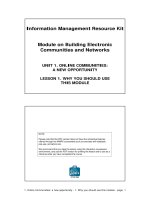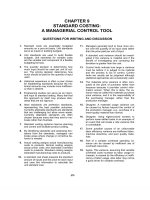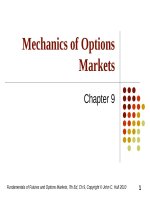macroeconomic mcgrowhill macro ch 9 19e use this one
Bạn đang xem bản rút gọn của tài liệu. Xem và tải ngay bản đầy đủ của tài liệu tại đây (657.7 KB, 46 trang )
09
Business Cycles, Unemployment,
and Inflation
McGraw-Hill/Irwin
Copyright © 2012 by The McGraw-Hill Companies, Inc. All rights reserved.
Chapter Objectives
• The Business Cycle and its
Primary Phases
• How Unemployment and
Inflation are Measured
• The Types of Unemployment
and Inflation and their Various
Economic Impacts
The Business Cycle
• Alternating increases and decreases
•
LO1
in economic activity over time
Phases of the business cycle
• Peak
• Recession
• Trough
• Expansion
9-3
The Business Cycle
Peak
Rec
ess
io
an
si
on
h
t
w
o
Gr
n
Re
ces
sio
n
Ex
pa
Peak
ns
i on
d
Tren
Trough
Ex
p
Level of real output
Peak
Trough
Time
LO1
9-4
The Business Cycle
U.S. Recessions since 1950
Period
Duration,
Months
Depth
(Decline in Real
Output)
1953-54
10
-2.6%
1957-58
8
-3.7
1960-61
10
-1.1
1969-70
11
-0.2
1973-75
16
-3.2
1980
6
-2.2
1981-82
16
-2.9
1990-91
8
-1.4
2001
8
-0.4
2007-09
18
-3.7
Source: National Bureau of Economic Research, and Minneapolis Federal Reserve
Bank, Output data are in 2000 dollars
LO1
9-5
Causation: A First Glance
• Business cycle fluctuations
• Economic shocks
• Prices are “sticky” downwards
• Economic response entails
decreases in output and
employment
LO1
9-6
Causation: A First Glance
• Causes of shocks
• Irregular innovation
• Productivity changes
• Monetary factors
• Political events
• Financial instability
• Example: Recession of 2007
LO1
9-7
Cyclical Impact
• Durable goods affected most
• Capital goods
• Consumer durables
• Nondurable consumer goods affected
less
• Services
• Food and clothing
LO1
9-8
Unemployment
• Twin Problems of the Business Cycle
– Unemployment
– Inflation
• Measurement of Unemployment
• Labor Force
• Unemployment Rate
– Part-Time Employment
– Discouraged Workers
Unemployment Rate
=
W 7.2
Unemployed
Labor Force
x 100
Phillips Curve
Unemployment
Unemployment rate =
Under 16
and/or
Institutionalized
(71.4 million)
Total
population
(307.3
million)
# of unemployed
labor force
Not in
labor
force
(81.7 million)
Employed
(139.9 million)
X 100
Unemployment rate =
Labor
force
(154.2
million)
14,265,000
154,142,000
X 100 = 9.3%
Unemployed
(14.3 million)
LO2
9-11
Unemployment
• Criticisms of unemployment
• Involuntary part-time workers
counted as if full-time
• Discouraged workers are not
counted as unemployed
LO2
9-12
Types of Unemployment
• Frictional unemployment
• Individuals searching for jobs or waiting to
•
•
LO3
take jobs soon
Structural unemployment
• Occurs due to changes in the structure of the
demand for labor
Cyclical unemployment
• Caused by the recession phase of the
business cycle
9-13
Definition of Full Employment
• Natural Rate of Unemployment (NRU)
• Full employment level of
unemployment
• Can vary over time
• Demographic changes
• Changing job search methods
• Public policy changes
• Actual unemployment can be above
or fall below the NRU
LO3
9-14
Economic Cost of Unemployment
• GDP Gap
• GDP gap = actual GDP – potential
•
LO3
GDP
• Can be negative or positive
Okun’s Law
• Every 1% of cyclical unemployment
creates a 2% GDP gap
9-15
Economic Cost of Unemployment
Economic Cost of Unemployment
LO3
9-16
Economic Cost of Unemployment
LO3
9-17
Unequal Burdens
• Occupation
• Age
• Race and ethnicity
• Gender
• Education
• Duration
LO3
9-18
Unequal Burdens
Unemployment Rates by Demographic Group: Full Employment Year (2007) and Recession Year (2009)*
Unemployment Rate
Demographic Group
Overall
Occupation:
Managerial and professional
Construction and extraction
Age:
16-19
African American, 16-19
White, 16-19
Male, 20+
Female, 20+
Race and ethnicity:
African American
Hispanic
White
Gender:
Women
Men
**
Education:
Less than high school diploma
High school diploma only
College degree or more
Duration:
15 or more weeks
LO3
2007
2009
4.6%
9.3%
2.1
4.6
7.6
19.7
15.7
24.3
29.4
39.5
13.9
21.8
4.1
9.6
4.0
7.5
8.3
14.8
5.6
12.1
4.1
8.5
4.5
8.1
4.7
10.3
7.1
14.6
4.4
9.7
2.0
4.6
1.5
4.7
9-19
Noneconomic Costs
• Loss of skills and loss of self-respect
• Plummeting morale
• Family disintegration
• Poverty and reduced hope
• Heightened racial and ethnic tensions
• Suicide, homicide, fatal heart attacks,
•
LO3
mental illness
Can lead to violent social and political
change
9-20
Global Perspective
LO3
9-21
Inflation
• General rise in the price level
• Inflation reduces the “purchasing
•
power” of money
Consumer Price Index (CPI)
CPI =
CPI =
LO2
Price of the Most Recent Market
Basket in the Particular Year
Price estimate of the Market
Basket in 1982-1984
207.3
-
201.6
201.6
x
x
100
100
= 2.8%
9-22
Inflation
Inflation Rates in Five Industrial Nations
LO2
9-23
Inflation
LO2
9-24
Types of Inflation
• Demand-Pull inflation
• Excess spending relative to output
• Central bank issues too much
•
LO3
money
Cost-Push inflation
• Due to a rise in per-unit input costs
• Supply shocks
9-25









